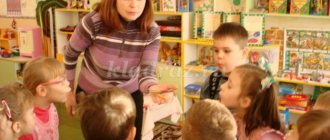1 Program content.
1. Clarify children’s knowledge about certain pieces of furniture and their purpose, teach them to correctly name different pieces of furniture and their parts, and understand the general word furniture.
2. Form the grammatical structure of speech: improve the ability to use simple prepositions.
3. Develop visual attention, visual memory, create prerequisites for the development of logical thinking.
4. Develop manual motor skills and precision of movements.
Material.
Flannelograph, toys for flannelgraph: bunny, fox, houses, stump, cubes, small toys for playing with the building, painting “Girl playing in a doll’s corner”, toy furniture, pictures: table, chair, armchair, wardrobe, doll, for applique: picture “Room”, stickers: cat, dog, cage with a bird, bear.
Progress of the lesson
I. Showing the beginning of the fairy tale “Zayushkina’s Hut” on a flannelgraph.
Teacher. Let's help the bunny and build a house for him. What should be in a house to make it comfortable to live there?
Children. We need a chair, a table, a bed—furniture.
Teacher. Let's build the bunny furniture from cubes.
II. Building furniture from cubes and playing with buildings.
Teacher. What kind of furniture did we build for the bunny? (Children name pieces of furniture, put a bunny on a chair, put toy dishes on the table, etc.)
III. Physical exercise to the music “Bunny”.
Teacher. The bunny says “thank you” and wants to dance with you. (Children move freely to the music.)
IV. Looking at the painting.
Teacher (shows the picture, asks questions, helps with answers if necessary). Look at the picture, the girl also has doll furniture. What is the girl doing? Where did she put the doll? Where will she feed the doll? Where will the doll be placed? Where will he put the doll plate? What is this? Why do you need a closet? What's in this closet? What is the name of the cupboard? The doll can sit on a chair, or maybe on...
Children. Armchair, sofa.
Teacher. Let's see what the chair has?
Children. Legs, seat, back.
Teacher. What's on the table?
Children. Legs, table top.
Teacher. You and I made furniture from cubes, but you can make a table and chair from our palms..
V. Finger play.
Teacher.
Legs, back and seat -
Here's a chair for you, surprisingly.
The table has four legs
The lid is like a palm on top.
(Children place four fingers (except the thumb) on the table, like the legs of a chair, palm parallel to the surface of the table)
VI. Game "Fourth wheel".
Teacher. Look at the pictures, what's missing here? A table, chair, sofa are furniture, and a doll is a toy.
VII. Didactic game “What’s missing?”
Teacher. This sheet of paper will be the room (places toy furniture on the sheet). What furniture did I put in the room? Close your eyes, now open them and tell me what’s missing.
VIII. Didactic game “Where the bear hid.” (Children, according to the teacher’s instructions, must find a plush
A lump under a chair, on a table, behind a sofa.)
IX. Application "Let's plant the animals."
Teacher. Look, the picture shows a room. What furniture is in this room? Let's put the cat on the chair and the dog under the table. The cage with the bird will be on the table, and next to the chair we will place the bear. (Children stick pictures.)
Abstract of educational activities for speech development for children of the 1st junior group: Furniture
Summary of educational activities for speech development for children of the 1st junior group “Furniture”.
Objectives: 1. Develop children’s ability to listen carefully to the teacher and answer questions asked. 2. Encourage children to name pieces of furniture. 3. To develop children’s ability to pronounce sounds correctly. Progress of the lesson: the teacher shows the children three bears. Educator: Guys, what fairy tale are these bears from? Children: From the fairy tale “The Three Bears”. Educator: Correct. What was Mashenka sitting on near the bears when she ate porridge? Children: On chairs. Educator: What were the cups of porridge on? Children: On the table. Educator: What did Mashenka sleep on? Children: On the bed. Educator: How can you call these objects in one word? Children: Furniture. Educator: That's right, this is furniture. Now let's relax a little and play. Finger gymnastics “Furniture”. One, two, three, four, five - Claps.
We will count furniture:
Squeeze and unclench your fingers.
Armchair, chair, sofa, stool,
Bend the fingers on the right hand, starting with the little finger.
Shelf, wardrobe, bed, bookcase.
Bend the fingers on your left hand, starting with the little finger. Educator: What kind of furniture do you have at home? Children: Sofa, chair, bed, wardrobe, table. Educator: Why do we need a sofa? Children: You can lie on the sofa, watch TV, play with toys. Educator: What can you do on the chair? Children: You can sit, read a book, look at pictures. Educator: What is the bed for? Children: We sleep on the bed, put the dolls to sleep. Educator: You answered all the questions correctly, well done. And in the bears’ house there is some furniture missing, what do you think? Where will mom Nastasya Petrovna put the dishes? Children: She needs a cupboard. Educator: Correct, where does Mikhail Ivanovich hang his clothes? Children: We need a wardrobe. Educator: That's right, guys. Now, I’ll check how you remember the name of the furniture. I will name pieces of furniture, and you show a picture of this furniture and name it. The bears will watch and remember too. Game: “Show and name the furniture.” Educator: Well done, guys, now Mikhail Ivanovich knows what furniture they lack and will make furniture for his family himself.
We recommend watching:
Scenario of spring entertainment for children of the junior group Summary of GCD, artistic activities in the 1st junior group for the New Year Summary of GCD on the topic: Winter for children of the first junior group Synopsis of GCD in the 1st junior group on artistic development
Similar articles:
Lesson summary for an early age group. Vegetables: turnips and carrots
Lesson summary for an early age group. Vegetables: beets and potatoes
Lesson summary for an early age group. Fruits: lemon and orange
Lesson summary for an early age group. Cat with kittens
Summary of a lesson in an early age group on a winter theme. Hare and fox




